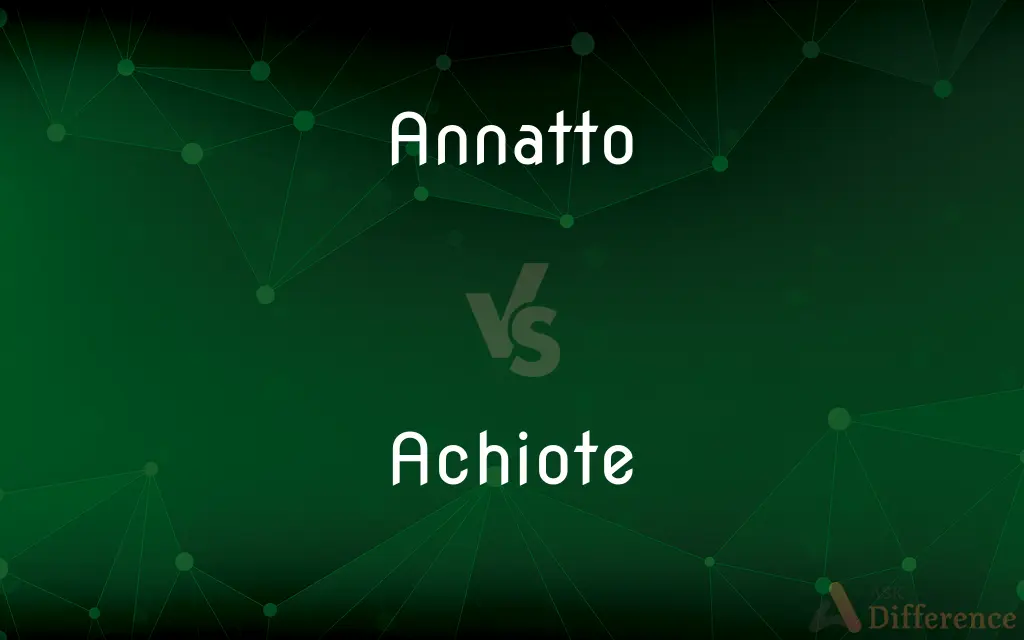Annatto vs. Achiote — What's the Difference?
By Tayyaba Rehman & Urooj Arif — Updated on April 7, 2024
Annatto is a natural food coloring and flavoring derived from the seeds of the achiote tree, while achiote refers to the tree itself and its seeds used in cooking.

Difference Between Annatto and Achiote
Table of Contents
ADVERTISEMENT
Key Differences
Annatto is primarily used for its vibrant orange-red color, imparting a subtle, earthy flavor to foods. It's often found in cheese, margarine, and rice dishes to enhance visual appeal. Achiote, on the other hand, encompasses the whole seed and its uses in culinary traditions, especially in Latin American cuisines, where it serves not just as a colorant but also as a key spice.
While annatto is extracted as a powder, paste, or oil for its coloring properties, achiote seeds are used whole, ground, or infused into cooking oils. This demonstrates how the form of use differentiates between the two, with annatto being a derivative product specifically for color and flavor, whereas achiote is used in its natural form.
In terms of culinary application, annatto is often associated with processed foods and industrial use to maintain color consistency in products. Achiote, conversely, is integral to traditional recipes, such as Mexican cochinita pibil or Yucatecan cuisine, highlighting its cultural and historical significance.
Annatto's subtlety allows it to blend into recipes without overpowering other flavors, making it a preferred choice in cheese making and bakery products. Achiote, however, is sought after for its more pronounced flavor and aroma, contributing to the distinctive taste profiles of dishes it is used in.
The health benefits attributed to annatto and achiote are similar, given their common source, including antioxidants and anti-inflammatory properties. However, the focus on annatto in dietary supplements highlights its specific compounds, like bixin, whereas achiote's benefits are often discussed in the context of traditional medicine and whole-food consumption.
ADVERTISEMENT
Comparison Chart
Definition
A natural colorant and flavoring agent extracted from achiote seeds.
The tree (Bixa orellana) and its seeds, used as a spice and colorant.
Primary Use
Coloring in food and cosmetics.
Spice in cooking and traditional medicine.
Form
Powder, paste, oil.
Seeds, ground or infused oil.
Culinary Application
Used in cheese, margarines, and processed foods.
Integral to Latin American cuisines, in dishes like cochinita pibil.
Flavor Profile
Subtle, earthy.
Pronounced, with a peppery note.
Compare with Definitions
Annatto
A natural dye extracted from achiote seeds, used in food and textiles.
Annatto gives cheddar cheese its orange color.
Achiote
The seed of the achiote tree, used as a spice and colorant in cooking.
Achiote seeds were soaked in oil to create a flavorful base.
Annatto
Annatto oil is used for both its flavor and color in cooking.
A few drops of annatto oil can transform a dish with its vibrant hue.
Achiote
Achiote tree, known scientifically as Bixa orellana.
The achiote tree's vibrant red seeds are harvested for culinary use.
Annatto
As a spice, annatto adds a subtle earthiness to dishes.
Annatto seeds were ground into a powder for the marinade.
Achiote
Achiote paste, made from ground seeds, spices, and vinegar, is a staple in Mexican cuisine.
Achiote paste was rubbed onto chicken before roasting.
Annatto
Annatto is rich in antioxidants, offering health benefits beyond its culinary uses.
Annatto supplements are taken for their anti-inflammatory properties.
Achiote
In traditional medicine, achiote is used for its healing properties.
Achiote leaves were brewed into a tea for stomach ailments.
Annatto
In cosmetics, annatto is used for coloring lipsticks and other products.
The lipstick gets its warm tone from annatto.
Achiote
Achiote's distinctive flavor and color are celebrated in Caribbean and Latin American dishes.
The rice was seasoned with achiote for its signature yellow color.
Annatto
Annatto ( or ) is an orange-red condiment and food coloring derived from the seeds of the achiote tree (Bixa orellana), native to tropical regions from Mexico to Brazil. It is often used to impart a yellow or orange color to foods, but sometimes also for its flavor and aroma.
Achiote
Chicken nuggets yum yum Guam keleguan lemon powder bakuku
Annatto
A tropical American evergreen shrub or small tree (Bixa orellana), having heart-shaped leaves and showy, rose-pink or sometimes white flowers.
Achiote
See annatto.
Annatto
The seed of this plant, used as a coloring and sometimes as a flavoring, especially in Latin American cuisine.
Achiote
A tropical American evergreen shrub, Bixa orellana; the lipstick tree.
Annatto
A yellowish-red dyestuff obtained from the arils of this plant's seeds, used especially to dye fabric and to color food products such as margarine and cheese. In all senses also called achiote.
Achiote
The seed of this tree used as a colouring or in Latin American cooking.
Annatto
(countable) A tropical American evergreen shrub, Bixa orellana; the lipstick tree; the fruit of the tree.
Achiote
An orange-red dye obtained from this seed.
Annatto
(uncountable) The seed of this tree used as a colouring or in Latin American cooking.
Achiote
Seeds of the annotto tree; also, the coloring matter, annotto.
Annatto
(uncountable) An orange-red dye obtained from this seed.
Common Curiosities
Is annatto safe for everyone?
Annatto is generally safe, though some individuals may have allergies or sensitivities to it.
Are annatto and achiote the same thing?
Annatto refers to the derivative products used for color and flavor, derived from the seeds of the achiote tree.
What is annatto used for?
Annatto is used as a natural coloring and flavoring agent in foods and cosmetics.
Can I substitute annatto for achiote in recipes?
Yes, annatto can be used as a substitute for achiote for color, but the flavor profile may differ slightly.
Can annatto color be extracted from achiote seeds?
Yes, annatto color is extracted from achiote seeds.
How do you use achiote in cooking?
Achiote can be used whole, ground into a powder, or infused into oils for cooking.
How do I make achiote oil?
Achiote oil can be made by infusing the seeds in hot oil until it turns a vibrant orange.
What dishes are best known for using achiote?
Latin American dishes like cochinita pibil are famous for their use of achiote.
What are the health benefits of annatto?
Annatto is rich in antioxidants and has been linked to anti-inflammatory properties.
What forms does annatto come in?
Annatto is available in powder, paste, or oil form.
How does the flavor of annatto compare to achiote?
Annatto has a subtler, earthy flavor, while achiote has a more pronounced, peppery note.
What is the main difference in use between annatto and achiote?
Annatto is primarily used for its color in food and cosmetics, whereas achiote is used both for its flavor and color in cooking.
Can annatto cause any side effects?
While rare, some individuals may experience side effects due to sensitivities or allergies to annatto.
Where can I find annatto or achiote?
Both can be found in specialty grocery stores, online, or in stores catering to Latin American cuisines.
Is achiote used in any traditional medicines?
Yes, achiote has been used in traditional medicines for various health issues.
Share Your Discovery

Previous Comparison
Hem vs. Fringe
Next Comparison
Corrugated vs. CorrugateAuthor Spotlight
Written by
Tayyaba RehmanTayyaba Rehman is a distinguished writer, currently serving as a primary contributor to askdifference.com. As a researcher in semantics and etymology, Tayyaba's passion for the complexity of languages and their distinctions has found a perfect home on the platform. Tayyaba delves into the intricacies of language, distinguishing between commonly confused words and phrases, thereby providing clarity for readers worldwide.
Co-written by
Urooj ArifUrooj is a skilled content writer at Ask Difference, known for her exceptional ability to simplify complex topics into engaging and informative content. With a passion for research and a flair for clear, concise writing, she consistently delivers articles that resonate with our diverse audience.















































